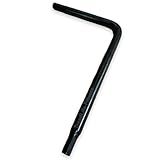Best Treadmill Calibration Tools to Buy in December 2025
Calibrating your treadmill to ensure accurate speed readings is essential for a valuable workout experience. Like maintaining any piece of fitness equipment, a calibrated treadmill ensures consistency, efficiency, and optimal performance during your exercise sessions. This guide provides a step-by-step process to effectively calibrate your treadmill for accurate speed, making your workouts in 2025 both enjoyable and precise.
Why Calibration is Crucial
Accuracy in speed readings is essential for tracking progress, setting goals, and ensuring safe workout sessions. Over time, even the top-of-the-line treadmills can show discrepancies in speed settings. Regular calibration can prevent misinformation regarding your workout metrics.
Steps to Calibrate Your Treadmill
1. Gather Your Tools
Before you begin, ensure you have the necessary tools: - A tape measure - A stopwatch or a reliable timer - A flashlight (optional for better visibility)
2. Follow the User Manual
Your treadmill’s user manual often contains specific instructions for calibration. The process can vary between models, so starting with the manufacturer’s guidelines is always a good idea. You can also visit top-rated treadmills for home to see if there are specific tips based on your model.
3. Measure the Belt Length
Using your tape measure, determine the length of your treadmill belt. This measurement is necessary for calculating the speed during the calibration process.
4. Mark a Section of the Belt
Mark a section of the belt with tape to identify its starting point. This mark will help in counting the number of revolutions during the calibration process.
5. Set Your Treadmill to a Low Speed
Turn on your treadmill and set it to a low speed, commonly around 3 mph. This speed makes it easier to count the complete revolutions of the belt.
6. Count the Revolutions
Using your stopwatch, start timing for one minute and count how many times the marked section crosses a set point, such as the front roller. Accurate counting is crucial for the next step.
7. Calculate the Actual Speed
Use the formula: [ \text{Speed (mph)} = \left(\frac{\text{Revolutions in 1 minute} \times \text{Belt Length (in feet)}}{5280 \text{ feet}}\right) \times 60 ]
Compare this with the treadmill’s displayed speed. If there is a discrepancy, consult your manual to adjust the speed settings.
8. Adjustment (If Necessary)
If the actual speed and displayed speed do not match, adjust the treadmill settings until they align. The adjustment process varies between models but is generally done through the console settings.
9. Test and Repeat
After making adjustments, test the treadmill again. Repeat the calibration process to confirm that the treadmill provides a more accurate speed reading.
Additional Tips
- Regularly check and maintain your treadmill to prevent mechanical issues affecting speed accuracy.
- Explore treadmills with different functionalities and features for easier calibration by visiting beginner-friendly treadmills 2025.
- Consider electricity-free options if you prefer no maintenance on motors, as covered in electricity-free treadmills.
Calibrating your treadmill ensures a reliable and efficient workout every time. Keep it a regular part of your treadmill maintenance routine for the most accurate exercise experience in 2025.



